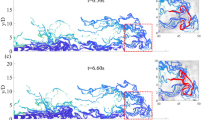Abstract
In the present study, numerical simulation was conducted to study both the internal and external flows of a fluidic oscillator in a quiescent environment and with a crossflow. Unsteady Reynolds-averaged Navier–Stokes analysis was used to evaluate the flow field. The blowing ratio was varied to understand the interaction between the free stream and the oscillating jet. Results for the time-averaged and the time-resolved flow fields were presented. The outlet velocity from the oscillator was not affected by the freestream flow for the tested three blowing ratios. Q criterion was used to evaluate the interaction of turbulent vortical structures from the fluidic oscillator with the crossflow. It was observed that two counter-rotating vortices and ring-like vortices were the important flow features of the external flow. As blowing ratio increases, the counter-rotating vortices become more asymmetric, move further from the wall, and are more spread.










Similar content being viewed by others
References
Seele R, Tewes P, Woszidlo R, McVeigh MA, Lucas NJ, Wygnanski IJ (2009) Discrete sweeping jets as tools for improving the performance of the V-22. J Aricr 46(6):2098–2106. https://doi.org/10.2514/1.43663
Seifert A, Greenblatt D, Wygnanski IJ (2004) active separation control: an overview of Reynolds and Mach numbers effects. Aerosp Sci Technol 8(7):569–582. https://doi.org/10.1016/j.ast.2004.06.007
Aubrun S, McNally J, Alvi F, Kourta A (2011) Separation flow control on a generic ground vehicle using steady microjet arrays. Exp Fluids 51(5):1177–1187. https://doi.org/10.1007/s00348-011-1132-0
Graff E, Seele R, Lin J, Wygnanski I (2013) Sweeping jet actuators—a new design tool for high lift generation. In: Innovative Control Effectors for Military Vehicles Conference, Stockholm, Sweden, 20–22 May, 2013
Raman G, Raghu S (2004) Cavity resonance suppression using miniature fluidic oscillators. AIAA J 42(12):2608–2612. https://doi.org/10.2514/1.521
Zamora M, Brown A, Dillon J, Khoo M, Shearhous A, Pafford B (2015) Sweeping jet actuators for drag reduction. In: 51st AIAA/SAE/ASEE Joint Propulsion Conference, Propulsion and Energy Forum, Orlando, FL, 27–29 July, 2015
Cattafesta L, Tian Y, Mittal R (2009) Adaptive control of post-stall separated flow application to heavy vehicles. In: The Aerodynamics of heavy vehicles ii: trucks, buses, and trains, lecture notes in applied and computational mechanics, Vol. 41, 2009, pp. 151-160. https://doi.org/10.1007/978-3-540-85070-0_12
Woszidlo R, Nawroth H, Raghu S, Wygnanski IJ (2010) Parametric study of sweeping jet actuators for separation control. In: 5th Flow Control Conference, Chicago, Illinois, 28 June–1 July, 2010. https://doi.org/10.2514/6.2010-4247
Gokoglu SA, Kuczmarski MA, Culley DE, Raghu S (2010)Numerical studies of a supersonic fluidic diverter actuator for flow control. In: 5th Flow Control Conference, Chicago, Illinois, 28 June–1 July, 2010. https://doi.org/10.2514/6.2010-4415
Hossain MA, Prenter R, Lundgreen RK, Ameri A, Gregory JW, Bons JP (2017) Experimental and numerical investigation of sweeping jet film cooling,. In: Proceedings of ASME Turbo Expo 2017: Turbomachinery Technical Conference and Exposition, Charlotte, NC, USA, 26–30 June, 2017. https://doi.org/10.1115/gt2017-64479
Cerretelli C, Wuerz W, Gharaibah E (2010) Unsteady separation control on wind turbine blades using fluidic oscillators. AIAA J 48(7):1302–1311. https://doi.org/10.2514/1.42836
Seele R, Graff E, Lin J, Wygnanski I (2015) Performance enhancement of a vertical tail model with sweeping jet actuators. In: 51st AIAA Aerospace Sciences Meeting including the New Horizons Forum and Aerospace Exposition, Grapevine, TX, United States, 7–10 January, 2015. https://doi.org/10.2514/6.2013-411
Pandey RJ, Kim KY (2018) Numerical modeling of internal flow in a fluidic oscillator. J Mech Sci Technol 32(3):1041–1048. https://doi.org/10.1007/s12206-018-0205-x
Gartlein S, Woszidlo R, Osermann F, Nayeri CN, Paschereit CO (2014) The time-resolved internal and external flow field properties of a fluidic oscillator. In: 52nd Aerospace Sciences Meeting, National Harbor, Maryland, 13–17 January, 2014. https://doi.org/10.2514/6.2014-1143
Ostermann F, Woszidlo R, Nayeri CN, Paschereit CO (2015) Experimental comparison between the flow field of two common fluidic oscillator designs. In: 53rd AIAA Aerospace Sciences Meeting, Kissimmee, Florida, 5–9 January, 2015. https://doi.org/10.2514/6.2015-0781
Aram S, Lee YT, Vargas A (2018) Computational fluid dynamic analysis of fluidic actuator for active flow control applications. AIAA J 56(1):111–120. https://doi.org/10.2514/1.J056255
ANSYS CFX (2010) Release 11.0: ANSYS CFX-Solver theory guide. ANSYS Inc., USA
Hirsch D, Gharib M (2018) Schlieren visualization and analysis of sweeping jet actuator dynamics. AIAA J 56(8):2947–2960. https://doi.org/10.2514/1.j056776
Holmen V (2012) Methods for vortex identification. Master’s thesis, Department of Mathematical Sciences, Lund University, the city of Lund in the province of Scania, Sweden, 2012
Johari H, Pacheco-Tougas M, Hermanson JC (1999) Penetration and mixing of fully modulated turbulent jets in crossflow. AIAA J 37(7):842–850. https://doi.org/10.2514/2.7532
Aram S, Shan H, Ostermann F, Woszidlo R (2018) Computational validation and analysis of interaction of a sweeping jet and an attached turbulent flow. In: 2018 AIAA Aerospace Sciences Meeting, Kissimmee, Florida, 8–12 January, 2018. https://doi.org/10.2514/6.2018-1798
Acknowledgements
This work was supported by the National Institute of Supercomputing and Network/Korea Institute of Science and Technology Information with supercomputing resources including technical support (KSC-2017-C1-0010).
Author information
Authors and Affiliations
Corresponding author
Ethics declarations
Conflicts of interest
The authors declare there is no conflict of interest.
Additional information
Publisher's Note
Springer Nature remains neutral with regard to jurisdictional claims in published maps and institutional affiliations.
Rights and permissions
About this article
Cite this article
Pandey, R.J., Kim, SH. & Kim, KY. Analysis of Interaction Between Oscillating Jet Issuing from a Fluidic Oscillator and a Crossflow. Int. J. Aeronaut. Space Sci. 22, 255–263 (2021). https://doi.org/10.1007/s42405-020-00313-3
Received:
Revised:
Accepted:
Published:
Issue Date:
DOI: https://doi.org/10.1007/s42405-020-00313-3




